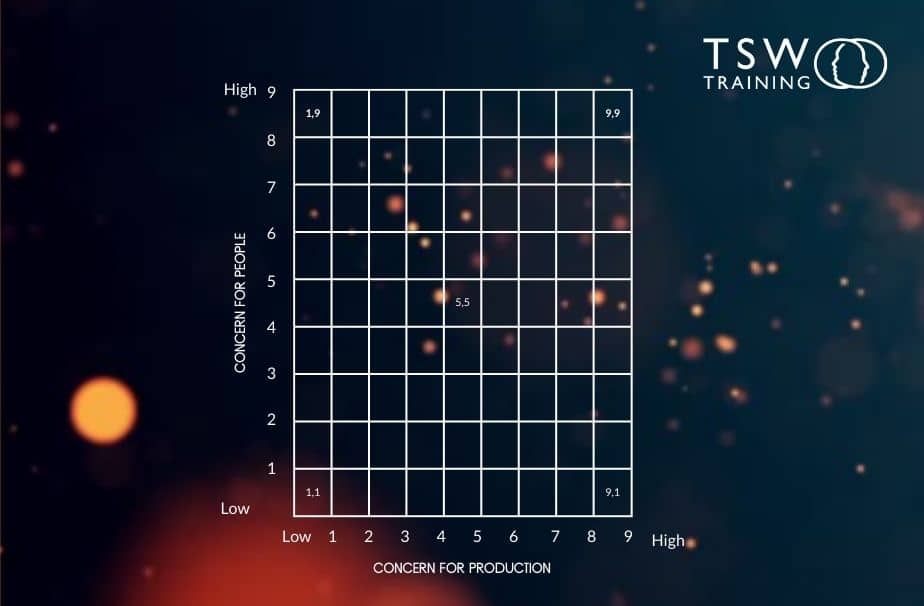Becoming a great leader is all about being self-aware, and knowing what to focus your attention on.
Different leadership theories and tools have come to the fore over the last century that can help you define your leadership style and, ultimately, shape your career progression.
One of these is the Blake Mouton managerial grid.
Key Points:
- The Blake Moulton Grid is a tool used to determine a person’s leadership style, based on their concern for people, and their concern for production.
- According to the Blake Mouton grid, there are five leadership styles based on what a leader prioritises.
- You can start to become a better leader by first identifying where you sit on the Blake Mouton managerial grid, and then making a plan on how to improve.
What is the Blake Mouton Grid?
The Blake Mouton grid was created by Robert Blake and Jane Mouton in 1964.
It’s a way of determining a person’s leadership style, based on their concern for people, and their concern for production. Those that have too much of a focus on production can see their people suffer from burnout and stress, while those who prioritise people over results can find that production slows right down.
The Blake Mouton grid is a simple matrix that has two axis, concern for results and concern for people. While there is no correlation between high concern for both (9,9 – Team Management), we know there is a causation that suggests that by focusing on achieving results and people simultaneously, you’ll get the best results.
The sweet spot of 9,9 seems to be the ideal balance for a leader.
What are the five leadership styles of the Blake Moulton Grid?
According to the Blake Mouton grid, there are five leadership styles based on what a leader prioritises. Let’s explore them in more detail.
1,1 – Impoverished Management
Managers who are low on both scores don’t have any regard for the employees in their care or the work that they do. Such a style in a leader can be detrimental to the business as they are not bothered about production levels, or whether their team are okay.
Impoverished management can result in little work being produced and staff motivation hitting rock bottom.
9,1 – Task Management
If a leader sits at 9,1 on the managerial grid, they are likely more concerned with task management than the people carrying out the work. Task Management has a huge focus on productivity but rarely looks at employee satisfaction or wellbeing. Managers will often look for the most efficient method of completing tasks, without considering the needs of the workers.
A workplace with managers focused solely on Task Management can lead to an unhappy workforce, a poor culture, and a high turnover.
5,5 – Middle of the road
A manager who balances people and production needs is a Middle of the Road leader. While they take the employee’s wellbeing into consideration, they’re also aware of business goals and the need to motivate their team to hit KPIs.
A Middle of the Road leader is constantly torn between people and production, which means their focus is always shifting.
1,9 – Country Club
Country Club management is defined by a high focus on people, and little emphasis put on production levels. Although someone in this category can be a very caring leader, their lack of attention to business goals can mean that the team falls behind with important work.
9,9 – Team Management
Described by some as the ideal space for a leader, Team Management pays plenty of attention to the people and the production. By taking care of their employees, they know they can motivate the team to produce great results.
Under the direction of a great leader, people and production come together in harmony to create a happy working environment where the team are consistently meeting business goals.
How to apply the Blake Mouton managerial grid
If you’re a manager, you can use the Blake Mouton grid to determine what kind of leader you are, and what your priorities are at work.
Example #1:
Beryl runs a cafe in a bustling town centre and manages a team of three people. On Monday mornings, the cafe is busy with workers coming in for a coffee to start the day. Employee satisfaction is the most important thing for Beryl, and she doesn’t like her staff to feel under pressure. She encourages them to take their time, and do their best, rather than motivating them to move faster so they can serve more people.
Some people within the queue become restless, and leave to find another coffee shop, meaning Beryl misses out on key sales.
Beryl would sit at 1,9 because she’s a Country Club manager, who prioritises her people above production. Although her staff are happy within their roles, her customers are disgruntled and may take their business elsewhere.
Example #2:
Nadiyah manages a team of six in a warehouse facility. Although things are busy, she checks in with her boss regularly to make sure her team’s goals are aligned with the wider business needs.
She keeps her team on track by giving them constructive feedback and rewarding them when they do a great job. Fortnightly 1:1’s also help her to check in on how they’re doing and what they think could be improved.
Nadiyah is 9,9 on the Blake Mouton grid – the perfect balance between people and production.
How can managers use this model to be better leaders?
You can start to become a better leader by first identifying where you sit on the Blake Mouton managerial grid. Think about situations you’ve been in that would determine where your focus predominantly lies – with people, production, or a balance of both.
Once you have a clear idea of your strengths and weaknesses, you can start to devise a plan to get you closer to that all-important 9,9 figure.
Many companies have adopted this approach to create great places to work that harness the energy of individuals. Even Sears built their strategies around this model of ‘Great place to work; Great place to shop; Great place to invest.’
Other such companies have included Boeing, Nike, Pepsi Co, Blizzard, Carnival Cruise Lines, and many more.
How can it help to produce better results?
When you’re more self-aware of your impact as a manager, you can make informed decisions on where to place your attention. Using the Blake Mouton grid to identify key leadership skills to improve can help you join a host of successful leaders who believe in high employee satisfaction and meeting important business needs to produce better results.
Defining your team management style and readjusting your focus if needed, is a great first step in understanding more about yourself as a leader. This leadership grid is an ideal way to get started.
Are there any disadvantages?
Although the Blake Mouton grid is a useful way to identify leadership styles and develop your managerial technique, newer theories have taken over in popularity, making it seem slightly outdated.
The Blake Mouton grid has largely been replaced by new thinking, such as the psychological contract, and newer writing such as ‘Clicks & Mortar’ by Pearce and Pottruck, which suggests getting a balance between the drive for results and the drive to create a ‘purposeful culture’.
How you can improve as a leader
It’s worth taking a look at lots of different leadership theories, such as McGregor’s Theory X and Y, Daniel Goleman’s Emotional Intelligence or Vroom’s Expectancy Theory, so you can get an all-round view of how you can improve as a leader, improve motivation in your team and produce better results for your organisation.








